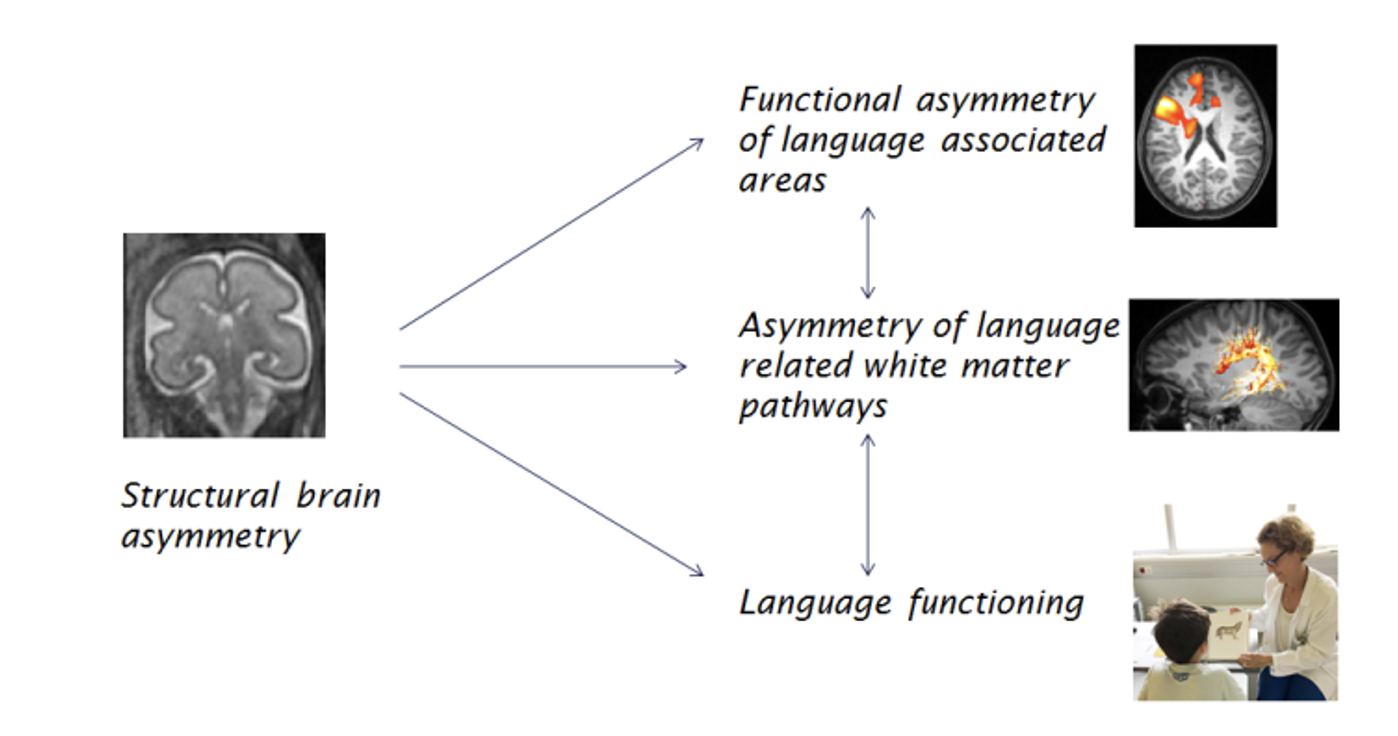
Funded by the FWF Programme Clinical Research
PI: Lisa Bartha-Doering
Project nr. FWF KLI 544
Duration 2016-2021
Background: The brain shows an asymmetry of its structures in most humans. The left hemisphere, especially the left temporal lobe, usually owns more volume and white matter bundles than the right hemisphere. An association between brain asymmetry and localization of language has already been proven. Furthermore, different studies underly the hypothesis that both brain structure and language localization are asociated with language competence. In a previous study, we could demonstrate that most fetuses show a brain asymmetry already in the 20th to 30th gestastional week. We are now interested in the relationship between prenatal asymmetry of brain structures and language localization and language competence in the same children several years later.
Aim: The present project aims to shed light on the relationship between prenatal anatomical asymmetry of the brain and later language localization, formation of language-related fiber bundles, and language abilities.
Hypotheses: We expect a significant association between prenatal brain asymmetry and later language localization and language competence.
Methods: We investigate healthy children, aged 6 to 16, all of whom had a magnetic resonance imaging in utero between the 20th and 30th gestational week. We perform a magnetic resonance imaging to investigate language-related white matter bundles and language localization. In addition, we perform an extensive language assessment in these children.
What is new? This study, for the first time, links prenatal data with later language abilities and language-related fiber bundles. With this knowledge, we hope to find early marker of later language abilities or language deficits.
Publications within this project so far:
Bartha-Doering L, Kollndorfer K, Schwartz E, Fischmeister F, Langs G, Weber M, Lackner-Schmelz S, Kienast P, Stümpflen M, Taymourtash A, Mandl S, Alexopoulos J, Prayer D, Seidl R, Kasprian G (2023) Fetal temporal sulcus depth asymmetry has prognostic value for language development. Communications Biology 6: 109. DOI: 10.1038/s42003-023-04503-z
Mandl S, Kienast P, Kollndorfer K, Kasprian G, Weber M, Seidl R, Bartha-Doering L (2023) Larger corpus callosum volume is favorable for theory of mind development in healthy children. Cerebral Cortex 33: 11197-11205. DOI: 10.1093/cercor/bhad353
Kollndorfer K, Novak A, Nenning KH, Fischmeister F, Seidl R, Langs G, Kasprian G, Prayer D, Bartha-Doering L (2023) Cortical thickness in the right medial frontal gyrus predicts planning performance in healthy children and adolescents. Frontiers in Psychology 14: 1196707. DOI: 10.3389/fpsyg.2023.1196707
Bartha-Doering L, Kollndorfer K, Schwartz E, Fischmeister FPS, Alexopoulos J, Langs G, Prayer D, Kasprian G, Seidl R (2021) The role of the corpus callosum in language network connectivity in children. Developmental Science 24: e13031. DOI: 10.1111/desc.13031
Kienast P, Schwartz E, Diogo M, Gruber GM, Brugger PC, Kiss H, Ulm B, Bartha-Doering L, Seidl R, Weber M, Langs G, Prayer D, Kasprian G (2021) The prenatal origins of human brain asymmetry: lessons learned from a cohort of fetuses with body lateralization defects. Cerebral Cortex 31: 3713-3722. DOI: 10.1093/cercor/bhab04
Bartha-Doering L, Kollndorfer K, Kasprian G, Novak A, Schuler AL, Fischmeister FPh, Alexopoulos J, Gaillard WD, Prayer D, Seidl R, Berl MM (2018) Weaker Semantic Language Lateralization Associated with Better Semantic Language Performance in Healthy Right-handed Children. Brain and Behavior 8: e01072. DOI: 10.1002/brb3.1072
Bartha-Doering L, Novak A, Kollndorfer K, Kasprian G, Schuler AL, Berl MM, Fischmeister FPS, Gaillard WD, Alexopoulos J, Prayer D, Seidl R (2018) When two are better than one: Bilateral mesial temporal lobe contributions associated with better vocabulary skills in children and adolescents. Brain and Language 184:1-10. DOI: 10.1016/j.bandl.2018.06.001
Schuler AL, Bartha-Doering L, Jakab A, Schwartz E, Seidl R, Kienast P, Lackner S, Langs G, Prayer D, Kasprian G. (2018) Tracing the structural origins of atypical language representation: consequences of prenatal mirror-imaged brain asymmetries in a dizygotic twin couple. Brain Structure and Function 223: 3757-3767. DOI: 10.1007/s00429-018-1717-y
Schwartz E, Nenning KH, Kasprian G, Schuler AL, Bartha-Doering L, Langs G (2017) Multivariate manifold modelling of functional connectivity in developing language networks. IMPI 2017. Lecture Notes in Computer Science: 1026: 311-322. Springer, Cham. DOI:10.1007/978-3-319-59050-9_25
Licandro R, Nenning KH, Schwartz E, Kollndorfer K, Bartha-Doering L, Liu H, Langs G (2017) Assessing reorganization of functional connectivity in the infant brain. IMPI Fetal, Infant and Ophthalmic Medical Image Analysis 2017. Lecture Notes in Computer Science: 1026:4-14. Springer, Cham. DOI: 10.1007/978-3-319-67561-9_2
